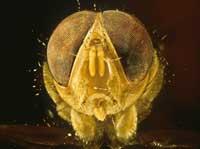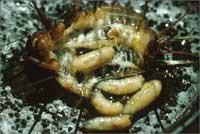The Kilker Male Stops Chanting
2006/11/12 Rementeria Argote, Nagore - Elhuyar Zientziaren Komunikazioa

On the island of Kauai, in Hawaii, lives the cricket of Teleogryllus oceanicus. In fact, it was a fairly abundant insect, but it began to decline in the 1990s. Reason: attack of a parasitic fly. The female fly Ormia ochracea lays its eggs on the cricket and the larvae born from the eggs feed the cricket inside.
Eulia uses a perfect strategy to know where the cricket is: follow its song. The aim of this peculiar kri-kri that arises when the cricket rubs the wings is to attract the female. But, as we have said, it not only attracts females of its species, but also receives parasitic female flies.

The cricket parasite is the Ormia ochracea fly. His ability to locate sounds makes him an example of developing hearing improvement devices. (Photo: R. Today and G. Haldeman / Cornell University. Copyright © Cornell University)
The female fly Ormia ochracea has an incredible ability to know where the sounds you hear come from: it has a very precise hearing for the direction (especially if you consider the small brain). At Cornell University, for example, it has been used as a model to develop hearing enhancement devices as new generation headphones.
Attentive researchers
Well, like the fly, researchers follow the cricket song to know where the crickets are. Researchers at the University of California discovered that the crickets were decreasing. They say that in 2001 there were hardly any shouts on the island.
But in 2003 they made a surprising discovery: the shackles were numerous, but very few males sang. When analyzing those male crickets they realized that the silent males had flat wings (in this way could not produce sound), so a mutation occurred. In addition, the mutation was extended as an advantage signal.

The success of the silent male crickets was evident in the reproductive era, as they were much more numerous than the singing crickets. But, apparently, if he did not sing, the male did not attract the females and thus could not reproduce. To find the reason for this success, researchers looked at the behavior of kilkers. And they discovered the key to the mystery. Behind this success there was a change of behavior: the silent crickets were accustomed to standing next to the singers. The singing of the songwriter attracted females and the silences became reproducers.
Currently, nine out of ten crickets are silent, that is, they do not sing to attract the female, and are therefore exempt from the attack of the parasitic fly. But kilker singers remain in danger and without them they cannot be reproduced. Therefore, what we know at the moment is that the Kauaiko cricket is abundant because it has easily adapted to prevent the attack of the parasitic fly. However, it may be in danger of extinction if kilker singers disappear. It is about to see what will happen in the future.
Published in 7K.



